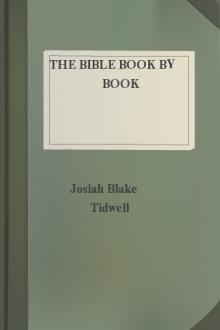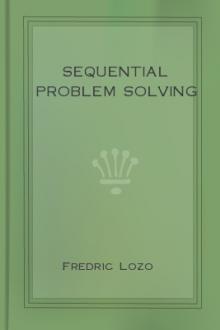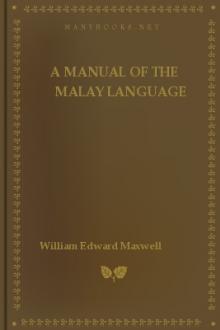The Bible Book by Book by Josiah Blake Tidwell (best short books to read .txt) 📕

- Author: Josiah Blake Tidwell
- Performer: -
Book online «The Bible Book by Book by Josiah Blake Tidwell (best short books to read .txt) 📕». Author Josiah Blake Tidwell
VII. Jacob, including Joseph, Chs. 37-50.
1. Jacob and Joseph, Chs. 37-45.
2. Sojourn in Egypt, Chs. 46-48.
3. Death of Jacob and Joseph, Chs. 49-50.
For Study and Discussion. (1) All that we may learn from this book concerning the nature and work of God. (2) The different things the origin of which this book tells: (a) Inanimate things, (b) Plant life, (c) Animal life, (d) Human life, (e) Devices for comfort and safety, (f) Sin and its varied effects, (g) Various trades and manners of life, (h) Redemption, (i) Condemnation. (3) Worship as it appears in Genesis, its form and development. (4) The principal men of the book and the elements of weakness and strength in the character of each. The teacher may make a list and assign them for study to different pupils. (5) List the disappointments, family troubles and sorrows of Jacob, and study them in the light of his early deception and fraud. (6) The over-ruling divine providence seen in the career of Joseph, with the present day lessons from the incidents of his life. (7) The fundamental value of faith in the life and destiny of men. (8) The Messianic promises, types and symbols of the entire book. List and classify them.
Exodus.
Name. The name Exodus means a going out or departure.
Subject The subject and key-word of the book is redemption (3:7, 8; 12:13 etc.), particularly that half of redemption indicated by deliverance from an evil plight. It records the redemption of the chosen people out of Egyptian bondage, which becomes a type of all redemption in that it was accomplished (1) wholly through the power of God, (2) by a means of a deliverer (3) under the cover of blood.
Purpose. At this point Old Testament history changes from that of the family, given in individual biographies and family records, to that of the nation, chosen for the divine purposes. The divine will is no longer revealed to a few leaders but to the whole people. It begins with the cruel bondage of Israel in Egypt, traces the remarkable events of their delivery and ends with a complete establishment of the dispensation of the Law. The aim seems to be to give an account of the first stage in the fulfillment of the promises made by God to the Patriarchs with reference to the place and growth of the Israelites.
Contents. Two distinct sections are usually given by students: the historical, included in chapters 1-19 and the legislative, comprising chapters 20-40. The first section records: the need of deliverance; the birth, training and call of the deliverer; the contest with Pharaoh; the deliverance and march through the wilderness to Sinai. The second gives the consecration of the nation and the covenant upon which it was to become a nation. The laws were such as to cover all the needs of a primitive people, both moral, ceremonial and civic with directions for the establishment of the Priesthood and Sanctuary.
Exodus and Science, Scientific research has gone far toward establishing the truthfulness of the Exodus record, but has brought to light nothing that in any way discounts it. It has shown who the Pharaoh of the oppression and Exodus was (Rameses. II, the Pharaoh of the oppression and Merenpth II, the Pharaoh of the Exodus.) and has discovered Succoth. It has shown that writing was used long before the Exodus and has discovered documents written before that period. It has thus confirmed the condition of things narrated in the Bible.
Analysis.
I. Israel in Egypt, 1:1-12:36.
1. The bondage, Ch. 1.
2. The deliverer, Chs. 2-4.
3. The contest with Pharaoh, 5:1-12:38.
II. Israel Journeying to Sinai, 12:37-18: end.
1. The exodus and passover, 12:37-13:16.
2. Journeying through Succoth to the Red Sea, 13:17-15:21.
3. From the Red Sea to Sinai, 15:22-18 end.
III. Israel at Sinai, Chs, 10-40.
1. The people prepared, Ch. 19.
2. The moral law, Ch. 20.
3. The civil law, 21:1-23:18.
4. Covenant between Jehovah and Israel, 23:20-24 end.
5. Directions for building the tabernacle, Chs. 25-31.
6. The covenant broken and renewed, Chs. 32-34.
7. The erection and dedication of the Tabernacle, 35-40.
For Study and Discussion. (1) The preparation of Israel and Moses for the deliverance. (2) The conception of God found in Exodus: (a) As to his relation to nature, (b) As to his relation to his enemies, (c) As to his relation to his people, (d) As to his nature and purposes. (3) The conception of man found in Exodus. (a) The need and value of worship to him, (b) His duty to obey God. (4) The plagues. (5) The divisions of the decalogue: (a) Those touching our relation to God. (b) Those touching our relation to men. (6) The different conferences between Jehovah and Moses, including Moses' prayer. (7) The current evils against which the civil laws were enacted and similar conditions of today. (8) The character of the different persons mentioned in the book: (a) Pharaoh, (b) Moses, (c) Aaron, (d) Jethro, (e) Magicians. (8) Amalek, etc. (9) The Messianic teachings of the book-here study (a) the sacrifices, (b) the material, colors, etc., of the Tabernacle, (c) the smitten rock, (d) Moses and his family.
Leviticus.
Name. By the rabbis, it was called "The Law of the Priest" and "The Law of Offerings," but from the time of the Vulgate it has been called Leviticus, because it deals with the services of the sanctuary as administered by the Levites.
Connection with Former Books. In Genesis, man is left outside of the Garden and the remedy for his ruin is seen in the promised seed. In Exodus, man is not only outside of Eden, but is in bondage to an evil enemy and his escape from his bondage is shown to be in the blood of the lamb, which is shown to be sufficient to satisfy man's need and God's justice. In Leviticus there is given the place of sacrifice, as an atonement for sin, and it is shown that God accepted the sacrifice of the victim instead of the death of the sinner. It is a continuation of Exodus, containing the Sinaitic legislation from the time of the completion of the Tabernacle.
Contents. Except the brief historical sections found in chapters 8-10 and 24:10-14, it contains a system of laws, which may be divided into (1) Civil, (2) Sanitary, (3) Ceremonial, (4) Moral and (5) Religious laws, emphasis being placed on moral and religious duties.
Purpose. (1) To show that God is holy and man is sinful. (2) To show how God can maintain his holiness and expose the sinfulness of man. (3) To show how a sinful people may approach a Holy God. (4) To provide a manual of law and worship for Israel. (5) To make Israel a holy nation.
Key-Word. The key-word then is Holiness, which is found 87 times in the book, while in contrast with it, the words sin and uncleanliness (in various forms) occur 194 times, showing the need of cleansing. On the other hand, blood, as a means of cleansing, occurs 89 times. The key verse is, I think, 19:2, though some prefer 10:10 as the best verse.
The Sacrifices, or Offerings. They may be divided in several ways, among which the most instructive is as follows: (1) National Sacrifices, which include (a) Serial, such as daily, weekly, and monthly offerings, (b) Festal, as the Passover, Cycle of Months, etc., (c) for the service of the Holy Place, as holy oil, precious incense, twelve loaves, etc. (2) Official Sacrifices, which include (a) those for the priests, (b) those for princes and rulers, and (c) those for the holy women, Ex. 38:8; 1 Sam. 2:22. (3) Personal Sacrifices, including (a) the blood offering-peace offering, sin offering and trespass offering, (b) the bloodless offerings-the meat, or meal, offering.
Besides this general division, the offerings are divided into two kinds, as follows: (1) Sweet-savor Offerings. These are atoning in nature and show that Jesus is acceptable to God because he not only does no sin, but does all good, upon which the sinner is presented to God in all the acceptableness of Christ. These offerings are (a) the burnt offering, in which Christ willingly offers himself without spot to God for our sins, (b) the meal offering, in which Christ's perfect humanity, tested and tried, becomes the bread of His people, (c) the peace offering representing Christ as our peace, giving us communion with God, and thanks. (2) Non-Sweet-Savor Offerings. These are perfect offerings, overlaid with human guilt. They are (a) the sin offering, which is expiatory, substitutional and efficacious, referring more to sins against God, with little consideration of injury to man, (b) the trespass offering, which refers particularly to sins against man, which are also sins against God.
Analysis.
I. Law of Sacrifices, Chs. 1-7.
1. Burnt offering, Ch. 1.
2. Meal offering, Ch. 2.
3. Peace offering, Ch. 3.
4. Sin offering, Ch. 4.
5. Trespass (or guilt) offering, 5:1-6:7.
6. Instructions to priests concerning the offerings, 6:8-7 end.
II. Law of Purity. Chs. 11-22.
1. Pure food, animals to be eaten, Ch. II.
2. Pure body and house, rules for cleansing, Chs. 12-13.
3. Pure nation, offering for sin on the day of atonement, Chs. 16-17.
4. Marriages, Ch. 18.
5. Pure morals, Chs. 19-20.
6. Pure priests, Chs. 21-22.
IV. Law of Feasts, Chs. 23-25.
1. Sacred feasts, Ch. 23.
2. Parenthesis, or interpolation, lamps of the Tabernacle, shew-bread, the blasphemer, Ch. 24.
3. Sacred years, Ch. 25.
V. Special Laws, Chs, 26-27.
1. Blessing and cursing, Ch. 26.
2. Vows and tithes, Ch. 27.
For Study and Discussion. (1) Make a list of the several offerings and become familiar with what is offered, how it is offered, the result to be attained in each case. (2) The laws (a) for the consecration and purity of the priests (Chs. 8-10 and 21-22), (b) governing marriages (Ch. 18), (c) concerning clean animals and what may be used for food (Ch, 11), (d) governing vows and tithes (Ch. 37). (3) The sacrifice of the two goats and two birds, (a) the details of what is done with each goat and each bird, (b) the lessons or truths typified by each goat and bird. (4) The name, occasion, purpose, time and manner of observing each of the feasts. (5) Redemption as seen in Leviticus, (a) the place of the priest, (b) of substitution, (c) of imputation, (d) of sacrifice and blood in redemption. (5) The nature of sin as seen in Leviticus, (a) its effect on man's nature, (b) its effect on his relation to God.
Numbers.
Name. It is named from the two enumerations of the people, at Sinai, Ch. 1. and at Moab, Ch. 26.
Connection with Former Books. Genesis tells of Creation, Exodus of redemption, Leviticus of worship and fellowship, and Numbers of service and work. In Leviticus Israel is assigned a lesson and in Numbers she is getting that lesson. In this book as in Exodus and Leviticus Moses is the central figure.
Central Thought. Service which involves journeying, which in turn implies walk as a secondary thought. All the types of the books bear upon this two-fold idea of service and walk.
Key-Phrase. "All that are able to go forth to war" occurs fourteen times in the first chapter. There was fighting ahead and all who could fight must muster in.
The History Covered is a period of a little more than thirty-eight years (Num. 1:1; Deut. 1:3) and is a record (1) of how Israel marched to the border of Canaan, (2) wandered thirty-eight years in the wilderness while the old nation died and a new nation was trained in obedience to God, (3) then returned to the border of the promised land.
Analysis.
I. The Preparation at Sinai, 1:1-10:10.
1. The number and arrangement of the tribes, Chs. 1-2.
2. The choice and assignment of the Levites, Chs. 3-4.
3. Laws for the purity of the camp, Chs. 5-6.
4. Laws concerning the offerings for worship, Chs. 7-8.
5. Laws concerning the passover and cloud, 9:1-14.
6. Signals for marching and assembling 9:15-10:10.
II. The Journey to Moab, 10:11-22:1.
1. From Sinai to Kadesh, 10:11-14 end.
2. From Kadesh to Kadesh (the wilderness





Comments (0)